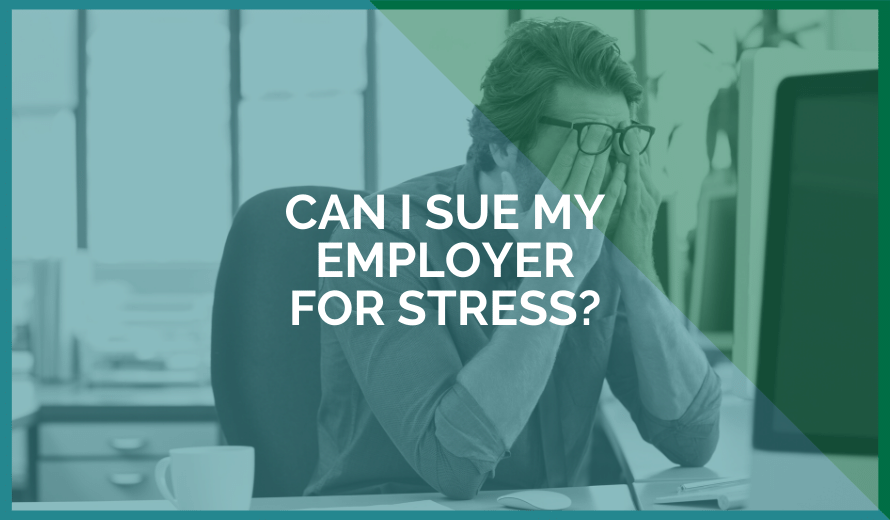Can I Sue for Emotional Distress?
Emotional distress is a deeply personal and often challenging experience. When someone’s actions or negligence causes you significant emotional harm, you might wonder if you can sue for emotional distress. This article delves into the legal aspects of emotional distress claims, helping you understand your rights, the prerequisites for filing a lawsuit, and what to expect.

Understanding Emotional Distress Claims
A. What Is Emotional Distress?
Emotional distress encompasses a wide range of emotional and psychological reactions to distressing events. It can manifest as anxiety, depression, fear, or even physical symptoms like headaches or stomachaches. In legal terms, emotional distress refers to the mental suffering resulting from another party’s actions or negligence.
Emotional distress claims typically fall into two categories: negligent infliction of emotional distress (NIED) and intentional infliction of emotional distress (IIED). NIED occurs when someone’s careless actions cause emotional harm, while IIED involves intentional actions meant to cause emotional distress.
B. Types of Emotional Distress Claims
Emotional distress claims can arise from various circumstances, including:
- Personal Injury: When an accident or injury results in emotional trauma alongside physical harm.
- Workplace Harassment: Instances of harassment, discrimination, or hostile work environments that cause significant emotional distress.
- Intentional Harm: Cases where an individual deliberately inflicts emotional suffering on another person.
Understanding the nature of your emotional distress is crucial when considering legal action. The type of claim you pursue may impact the legal requirements and potential outcomes of your case.
Legal Considerations for Emotional Distress Lawsuits
A. Establishing Negligence or Intentional Infliction
To succeed in an emotional distress lawsuit, you must establish that the defendant’s actions were either negligent or intentionally harmful. For NIED claims, you need to show that the defendant’s conduct fell below a reasonable standard of care, leading to your emotional distress.
For IIED claims, you must demonstrate that the defendant’s behaviour was extreme and outrageous, intentionally causing you severe emotional distress. Proving intent can be challenging, so consult with an attorney to assess the viability of your case.
B. Damages and Compensation
In emotional distress cases, damages typically include compensation for therapy, counselling, medical expenses, and lost wages resulting from the distress. Additionally, you may be eligible for non-economic damages, such as pain and suffering, which can vary significantly based on the severity of your emotional distress.
Your attorney will play a crucial role in assessing the appropriate damages to seek and building a strong case to support your claim.
C. Statute of Limitations
Every legal claim has a time limit within which it must be filed, known as the statute of limitations. For emotional distress claims, this time frame varies by jurisdiction and the nature of the claim. It’s essential to be aware of and adhere to these deadlines, as failing to file within the specified timeframe may result in the dismissal of your case.
Real-Life Cases and Precedents
A. Notable Emotional Distress Lawsuits
Examining real-life emotional distress lawsuits can provide valuable insights into the legal process and potential outcomes. Some notable cases include:
- Emotional Distress in Employment: Cases where employees sued their employers for emotional distress due to workplace harassment, discrimination, or wrongful termination. Outcomes vary, with some plaintiffs receiving substantial settlements.
- Personal Injury Claims: In personal injury cases, plaintiffs often include emotional distress claims alongside physical injuries. Successful outcomes typically involve strong evidence linking the defendant’s actions to the emotional suffering.
B. Legal Precedents
Legal precedents are past cases that have established principles or rules used in current judgments. Precedents play a significant role in shaping emotional distress lawsuits. For example, a precedent might determine the level of intent required for an IIED claim or the types of damages awarded.
Understanding legal precedents can help attorneys build stronger cases and provide you with realistic expectations for your emotional distress claim.
Alternatives to Lawsuits
A. Mediation and Settlements
Litigation is not the only path for resolving emotional distress claims. Mediation and negotiated settlements offer alternatives that can save time, money, and emotional stress.
Mediation involves a neutral third party facilitating negotiations between you and the defendant. If an agreement is reached, it can provide a more amicable resolution without the adversarial nature of court proceedings.
B. Seeking Professional Help
Regardless of whether you pursue legal action, seeking professional help for emotional distress is essential. Therapy, counselling, or psychiatric care can be instrumental in addressing and coping with the emotional trauma you’ve endured.
Your mental well-being should always be a priority, and professional support can aid in your recovery, whether or not you decide to sue.
FAQs (Frequently Asked Questions)
Q1: What qualifies as emotional distress for a lawsuit?
A1: Emotional distress in a lawsuit refers to significant emotional or psychological suffering caused by another party’s actions or negligence. It can manifest as anxiety, depression, fear, or physical symptoms. To qualify, you must establish that the distress resulted from the defendant’s conduct, whether negligent or intentional.
Q2: Can I sue for emotional distress caused by workplace harassment?
A2: Yes, you can sue for emotional distress resulting from workplace harassment. Such claims fall under employment law and may involve hostile work environments, discrimination, or wrongful termination. Documenting the harassment and seeking legal counsel are essential steps if you plan to pursue a lawsuit.
Q3: What evidence is needed for an emotional distress claim?
A3: Evidence for an emotional distress claim may include medical records, therapy or counselling records, witness testimonies, emails, texts, or other communications that demonstrate the defendant’s actions or intent. Consult with an attorney to gather and present the necessary evidence for your specific case.
Q4: Is it possible to sue for emotional distress without physical injuries?
A4: Yes, it is possible to sue for emotional distress without physical injuries. Emotional distress claims can stand alone, but they often accompany personal injury cases. To succeed, you must provide compelling evidence linking the defendant’s actions to your emotional suffering.
Q5: What role does intent play in emotional distress cases?
A5: Intent is a crucial factor in emotional distress cases. For intentional infliction of emotional distress (IIED) claims, you must prove that the defendant’s actions were extreme and outrageous, done intentionally to cause you severe distress. Negligent infliction of emotional distress (NIED) claims involve proving negligence but do not require intent.
Q6: How long do I have to file an emotional distress lawsuit?
A6: The statute of limitations for emotional distress lawsuits varies by jurisdiction and the nature of the claim. It can range from one to several years. It’s crucial to consult with an attorney to determine the specific time frame applicable to your case and ensure timely filing.
Conclusion
Suing for emotional distress is a complex legal process with various considerations, including the type of distress, establishing liability, and understanding damages. While pursuing a lawsuit is an option, alternatives like mediation and seeking professional help should not be overlooked.
Remember that your mental well-being is paramount. If you believe you have a valid emotional distress claim, consult with an attorney experienced in personal injury or employment law. They can guide you through the legal process, help you gather evidence, and assess the viability of your case.
In the end, whether through litigation or alternative methods, the goal is to find resolution and relief from the emotional suffering you’ve endured.






